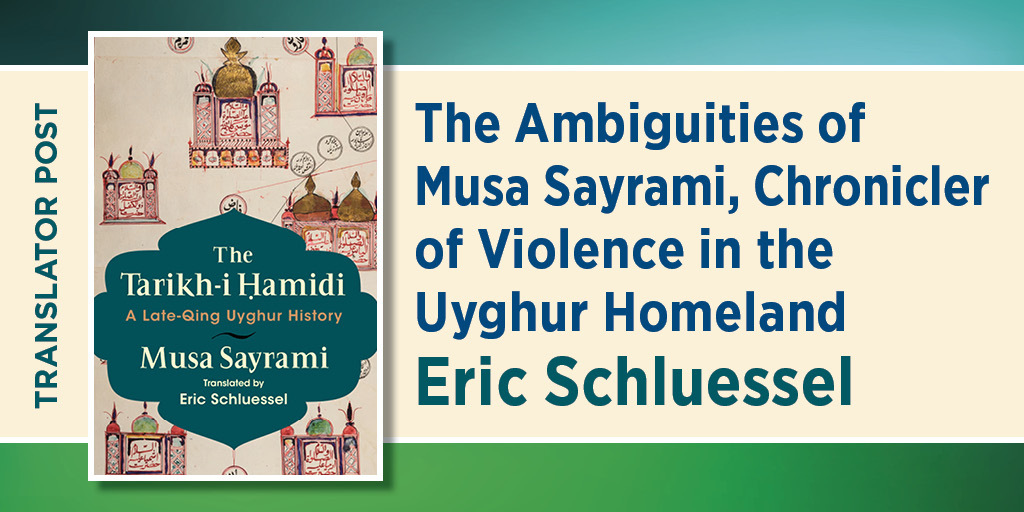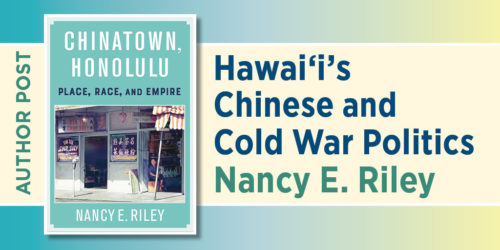The Ambiguities of Musa Sayrami
Chronicler of Violence in the Uyghur Homeland
Eric Schluessel

“The common people hoped and begged for the Emperor of China, and they wept, and in their weeping, they supplicated as never before.”[1]
The first time I read that sentence, it baffled me. It was written in the Uyghur homeland, called Xinjiang or East Turkestan, and its author was one of the most celebrated historians and writers in the Uyghur tradition. Today, the Uyghur region is in the news for the Chinese state’s efforts to control and assimilate its ethnically non-Chinese, Muslim-majority population by any means, including pervasive surveillance, reeducation, and imprisonment. These policies, which Chinese President Xi Jinping intends to continue indefinitely, represent the endpoint of a decades-long conflict between two principles: the globally recognized right of every people, such as the Uyghurs, to self-determination and China’s demand for national sovereignty. Uyghurs and other minoritized peoples in northwestern China are forced to make a choice: join the nationalizing project or disappear.
A century ago, in the twilight of the old Eurasian empires, before we lived in a world of nation-states, that choice was not so binary. This passage was written at the dawn of the twentieth century by Musa Sayrami (1837–1917). It was not written for Chinese consumption, either—it comes from the Tarikh-i Ḥamidi, a book written in Chaghatay, the immediate ancestor of the Uyghur language. The Tarikh-i Ḥamidi provides an exciting chronicle of the Uyghur region’s tumultuous nineteenth century. It focused on the 1860s–1870s, when a series of events commonly called the “Muslim uprisings” rocked the northwestern regions of the Qing empire (1644–1912), including Xinjiang.
Sayrami was a participant in an early uprising, but he soon grew disillusioned as a series of Islamic states rose and fell, and along with them the promise of just and independent rule. The most famous and successful of these states was established by an officer from the nearby Khanate of Khoqand, Yaʿqub Beg (1820–1877). Sayrami describes Yaʿqub Beg as a charismatic but cruel leader whose early justice soon gave way to arbitrariness and greed. Overtaxed farmers, Sayrami writes, “begged for the Emperor of China” to return, as the promise of Islamic government had turned out empty. Yaʿqub Beg died in 1877, just as the Qing armies swept over the region, meeting little resistance from his remaining foreign officers, who fell into infighting or fled.
Uyghurs and other minoritized peoples in northwestern China are forced to make a choice: join the nationalizing project or disappear.
In the aftermath, the people of East Turkestan seem to have been left wondering what could have happened for Islamic rule to rise and then fall again in the face of a non-Muslim reconquest. Some chroniclers wrote heroic histories that celebrated Yaʿqub Beg and held that Islamic rule had simply been betrayed by Qing sympathizers.
Sayrami was different. Over the years of the uprisings, he had been a teacher, an official, a negotiator, a captive, and eventually a tax collector under Yaʿqub Beg’s regime. Sayrami witnessed the course of events from the middle, and he had seen how the corruption and arrogance of the powerful had turned into suffering for the common people. The Tarikh-i Ḥamidi was thus written not so much to celebrate as to critique, to recollect stories fading from collective memory, and to make some rational sense of their narrative strands. While Sayrami held firmly to the methods of traditional Central Asian Islamic history writing, which had for centuries been directed to the glorification of royal patrons, he sought rational causes in the world, voiced skepticism toward legends that upheld the powerful, and even directed his pen of judgment at Yaʿqub Beg, the Ottoman caliph, and the Qing emperor alike.
Sayrami ultimately decided that the politics of his world operated according to a simple mechanism, one inscribed in the Quran itself: God remands the care of His people to whom He will, and specifically to those who are like good shepherds unto a flock. Sometimes the best shepherd is not a Muslim.
Well, not exactly. Sayrami, for all his skepticism, takes pains to demonstrate the unique world-historical qualities of China and its ruler. Contrary to tradition and history, he demonstrates that China cannot be conquered and that, in fact, its ruler is the descendant of an ancient emperor who secretly became a Muslim himself. These legends are part of the apparatus that Sayrami rallies in order to make China and Chinese power intelligible in Islamic terms. Somewhere in these stories is buried the promise of justice in accordance with Shariah—that is, hope that the Qing empire would allow Muslims to live as Muslims, as the Qing was thought to have done in the century prior to the uprisings.
Somewhere in these stories is buried the promise of justice in accordance with Shariah…
Indeed, there is a heavy quality of nostalgia to Sayrami’s work, as the violence of the uprisings and the internecine struggles that followed appears as a senseless loss. Sayrami himself recalls incidents of horrible violence, some he was involved in and clearly struggles to justify and others he casts as unforgivable injustices. To him and many like him, the uprisings constituted a moment when the course of history changed irrevocably. The post-reconquest Qing regime was not like the pre-uprisings Qing—the new rulers of Han Chinese activists dedicated to transforming the Muslim population into ideal Confucians, a topic I treat extensively in Land of Strangers (Columbia, 2020). Sayrami, like many of his contemporaries, struggled to accept this more aggressive form of rule and remembered the earlier Qing as an ideal state. He himself even compares the late-Qing government to a kind of undead beast, unwisely summoned back from the grave. This undead empire, by then ravaged by decades of internal conflicts and incursions by Western empires, seems transformed, perhaps even on the verge of collapse. What is the state of the world when the indomitable empire falls?
Sayrami wrote and revised his chronicle over the course of a decade, and as he wrote, his account and evaluation of Chinese rule changed. Ultimately, the Tarikh-i Ḥamidi records a profound ambiguity. Sayrami tells us that native Muslim officials—his comrades—partly rejoiced for the Qing’s return, but they also put on smiles and tolerated it, knowing that there was no choice but submission.
Together, Sayrami’s discussions of the Qing and of Chinese power, and of his own class’s relationship to it, reflect some of the ambiguities common in colonial literature. He is not the only author from a conquered people to have used the tools of his own tradition to make sense of the ruling power and its rise, or for that matter to determine a reason the conquered people are ultimately more powerful. Nor is he the only minor official to reason through the problems of collaboration. Sayrami’s chronicle reflects a sensibility that predates the hegemony of the nation-state, although we can see in it the hardening of boundaries that would inform later national projects. That sensibility allowed for kinds of boundary crossing and ideas of legitimacy, articulated through religion and legends of ancient covenants, that do not square easily with the modern nation-state’s demand for homogeneity.
Ultimately, the Tarikh-i Ḥamidi records a profound ambiguity.
That said, we would be fooling ourselves to think that empires or their ethnic politics are entirely dead. After all, the national identities we now know arose in imperial cores in part through interaction with imperial peripheries—that is, empire made nations. The Qing’s abortive attempt to Sinicize East Turkestan in the late nineteenth and early twentieth century, Sayrami’s time, was in part a response to the question of what it meant to be Chinese, as this identity was challenged not only in the face of Western aggression but also by the rule of the foreign Manchus and in the context of Chinese migration into the Qing’s frontiers. Today, other territorially expansive, multiethnic states—that is, empire-like formations such as modern China—contain the possibility of a confident pluralism like the one that Sayrami recalled from before the uprisings.
At the same time, struggling states of this type have often chosen to pursue a desperate, even paranoid drive to transform the hearts and minds of their internal Others. Because it is impossible to prove a thought crime, such states rely on restrictions of personal expression in the body, clothing, or language, or try to restrict inputs that might cause, to use one Chinese term, “spiritual pollution.” For example, Sayrami’s own work has been banned in Xinjiang as the authorities have—absurdly, I think you will agree—declared it an example of “Islamic extremism.” Its most recent Uyghur-language edition, prepared in China by a vaunted professor from Minzu University, has now been published abroad, its editor in exile.
With the publication of this first English-language translation, the Tarikh-i Ḥamidi will doubtless be open to a great diversity of interpretations. May Sayrami’s critical, reflexive, and ambiguous text help us all think beyond simple binaries.
Eric Schluessel is an associate professor of history and international affairs at the George Washington University. He is the translator of The Tarikh-i Ḥamidi: A Late-Qing Uyghur History.







